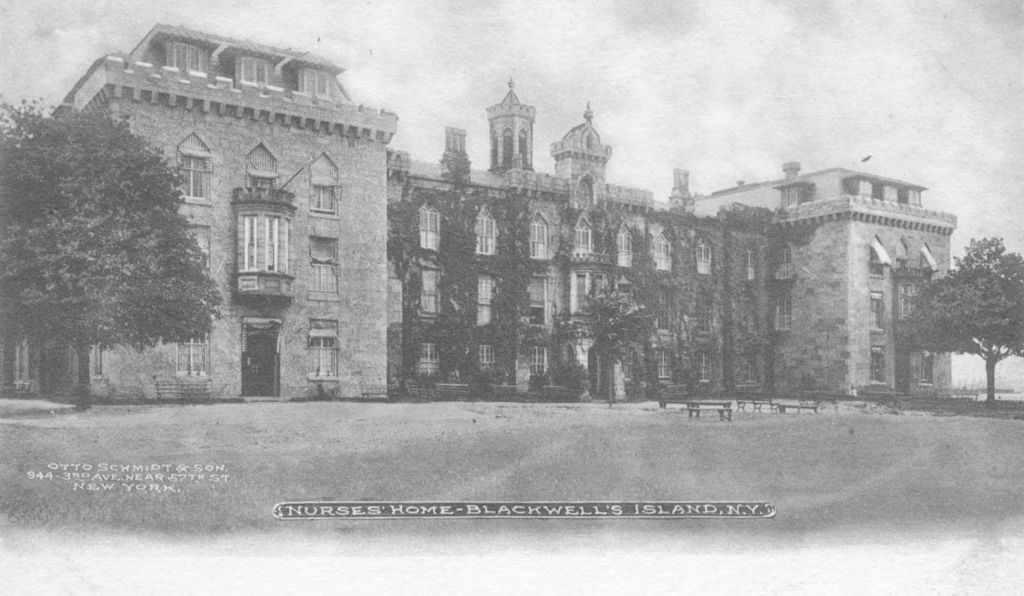Friday, January 31, 2025 – PROFESSIONAL NURSING HISTORY STARTED HERE IN 1877


Finding Women in the Archives:
Student Nurses
Friday, January 31, 2025
ISSUE #1382
NEW-YORK HISTORICAL SOCIETY
FROM THE STACKS
Nursing, which as a profession has long been associated with women, offered opportunities not only for education and employment, but leadership. Long before American women could vote, they were able to influence public policy, often through professional organizations, such as those formed by nurses in the early 20th century.
Student Nurses in the Orrin Sage Wightman Collection
In 1916, Dr. Orrin Sage Wightman, internist and avid photographer, made a series of photographs showing student nurses from City Hospital at work on Blackwell’s Island. Dressed in tall pleated caps and long aprons, the young women take care of patients, weigh babies, assist surgeons, make beds, fill bottles, and take cooking classes. A fascinating window into one of America’s earliest hospital-based nurse training programs, the photos depict a nurse’s daily routine at a time when the nursing profession was adjusting to a series of momentous changes.

Student nurses tend to babies on Blackwell’s Island, 1916. Orrin Sage Wightman Collection. New-York Historical Society Library.
Nursing Education in New York City
Although professional nurses were nothing new (George Washington’s ledgers detail the fees paid to nurses during the Revolution), the overwhelming demands of the Civil War had demonstrated the country’s urgent need for nurses trained in hygiene and patient care. The demand for trained nurses remained acute after the Civil War was over. As more and more people flocked to dense urban centers, public hospitals strained to cope with growing populations of sick and impoverished patients. In response, philanthropist Louisa Lee Schuyler, founder of the State Charities Aid Association, helped institute and fund a Training School for Nurses at Bellevue Hospital in 1873–74, the first such program in the United States. When City Hospital (then called Charity Hospital) opened its own School of Nursing in 1877, it became the nation’s fourth.
Initially, nursing education consisted of two to three years of practical training in patient care and cleanliness. As Wightman’s pictures indicate, the student nurses provided valuable labor, but the hospitals they worked in rarely hired them as staff nurses once they had graduated.

Student nurses tend to babies on Blackwell’s Island, 1916. Orrin Sage Wightman Collection. New-York Historical Society Library.
Nurses at Work in New York
While many graduates became private nurses—that is, nurses who were hired directly by patients on a temporary basis—by 1916 the range of job opportunities for nurses had increased. Lillian Wald, founder of the Henry Street Settlement, pioneered the field of public health nursing in 1893. (Wald is featured in our new women’s history film, We Rise, and her work in the settlement house movement is discussed in our Massive Open Online Course, Women Have Always Worked.) In 1901, the Army formally established its own Nurse Corps, and the Navy followed suit in 1908. Meanwhile, in 1902, Lina Roberts of New York City had become the first school nurse in the United States. Wald remained active into the 20th century: In 1909 she partnered with the insurance giant Metropolitan Life to employ home nurses to visit sick policyholders, and in 1912 she spearheaded a nationwide Public Health Nursing Service in partnership with the American Red Cross.

Student nurses observe a surgery on Blackwell’s Island, 1916. Orrin Sage Wightman Collection. New-York Historical Society Library.
In keeping with their professional training, New York’s nurses formed a professional association—the first for nurses in the country— in 1901. By 1902, the New York State Nurses’ Association began to press for a law that would establish uniform standards for nursing education and practice. The resulting Nurse Practice Act provided for state examination and certification of nurses, and created the title of Registered Nurse. The first states to pass nurse registration laws—New York, North Carolina, Virginia, and New Jersey—all did so in 1903.
In 1905, the president of the New York Nurse Board of Examiners, Sophia Palmer, wrote that the state required nurses to be trained and examined in medical and surgical nursing, obstetrical nursing, the nursing of sick children, and “diet cooking for the sick.” Wightman’s photographs show the student nurses engaged in just such activities during their training on Blackwell’s Island.

A nursing student tends to an infant on Blackwell’s Island, 1916. Orrin Sage Wightman Collection. New-York Historical Society Library
Nursing on Blackwell’s Island
In Wightman’s time, the city was about to rebrand Blackwell’s Island (today known as Roosevelt Island), which had a fearsome reputation, with the benign-sounding moniker “Welfare Island.” In the 19th century, the island had been the grim home of a penitentiary. Its former inmates included the infamous abortion provider known as Madame Restell and the equally infamous anarchist Emma Goldman, both featured in our Women’s Voices exhibit. The island also housed a smallpox hospital, a workhouse, and the city’s Lunatic Asylum. In 1887, the island’s asylum had been the subject of journalist Nellie Bly’s “Ten Days in a Mad-House,” a chilling exposé which detailed the inadequate food and clothing given to patients, overcrowding within the facility, and mistreatment from the nurses on staff. Bly’s investigation, part of a larger reassessment of how the city coped with problems of poverty and illness, helped spur desperately needed institutional reforms.

Nursing students at a patient’s bedside on Blackwell’s Island, 1916. Orrin Sage Wightman Collection. New-York Historical Society Library.
Nursing Reforms in City, State, and Nation
One reform that did not take place until the mid-20th century was desegregation. Until 1923, the privately funded Lincoln School for Nurses in the Bronx was the only institution in New York City that trained African American women. Founded in 1898, it was the first school of its kind in the United States. (Mary Eliza Mahoney, the country’s first professionally trained African American nurse, graduated from Boston’s New England Hospital for Women and Children in 1879 under a quota system that admitted one African American woman and one Jewish woman per class.) To press for the end of racial discrimination in the nursing profession, in 1908 fifty-two women formed the National Association of Colored Graduate Nurses in New York. However, it was not until World War II that severe nursing shortages caused state-level nursing associations to admit African American members, and it was not until the passage of the Civil Rights Act in 1964 that the federal government mandated desegregation in hospitals and nursing schools.

Student nurses on Blackwell’s Island, 1916. Orrin Sage Wightman Collection, New-York Historical Society Library.
–Jeanne Gutierrez, Center for Women’s History
This post is part of our new series, “Women at the Center,” written and edited by the staff of the Center for Women’s History. Look for new posts every Tuesday! #womenatthecenter
COMING TO THE NYPL BRANCH ON
FEBRUARY 18TH
WHEN MANHATTAN WAS DUTCH—THE 400TH ANNIVERSARY EDITION
The Dutch of the early 17th century turned an edge of Manhattan wilderness into New Amsterdam. Although it lasted only 40 years, the colony had a profound and lasting impact on the future city of New York. From the start, people of many ethnicities filled its streets, trade and profit were paramount, and religious tolerance was the norm.
With Joyce Gold- Historian and noted NYC Tour Guide
This program is free and open to the public.
TIme: 6:30 p.m.
PHOTOS OF THE DAY

Louisa Lee Schuyler (1837-1926) founded the New York State Charities Aid Association in 1873. Shortly thereafter, she founded the nation’s first nursing school, at Bellevue Hospital in New York City. When philanthropist Margaret Olivia Slocum Sage formed the Russell Sage Foundation in 1907, she appointed Schuyler a founding trustee.
Image description: sitting portrait of Louisa Lee Schuyler, a white woman dressed in a dark, ruffled shirt. The image caption reads, “Great-granddaughter of Alexander Hamilton, and founder of the State Charities Aid Association.”

The center building of the Nurses Home (Smallpox Hospital) was named in honor of Louisa Schuyler, Schuyler Hall.
CREDITS
NEW -YORK HISTORICAL SOCIETY
FROM THE STACKS
–Jeanne Gutierrez, Center for Women’s History
This post is part of our new series, “Women at the Center,” written and edited by the staff of the Center for Women’s History. Look for new posts every Tuesday! #womenatthecenter
All image are copyrighted (c) Roosevelt Island Historical Society unless otherwise indicated
THIS PUBLICATION FUNDED BY DISCRETIONARY FUNDS FROM CITY COUNCIL MEMBER JULIE MENIN & ROOSEVELT ISLAND OPERATING CORPORATION PUBLIC PURPOSE FUNDS.


Copyright © 2024 Roosevelt Island Historical Society, All rights reserved.Our mailing address is:
rooseveltislandhistory@gmail.com

Leave a comment